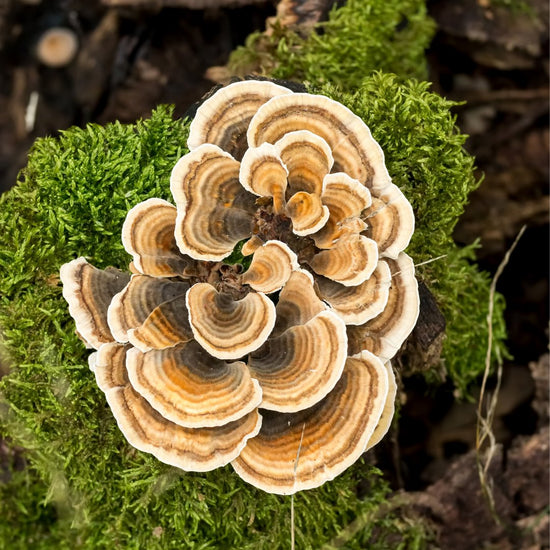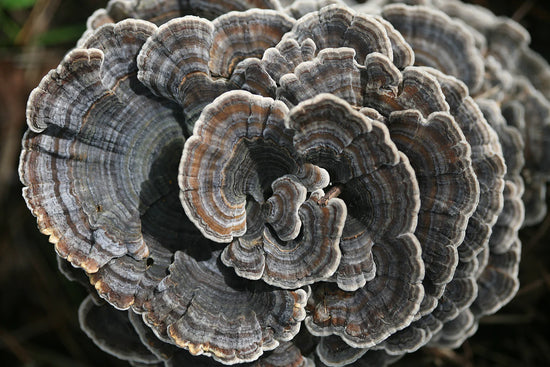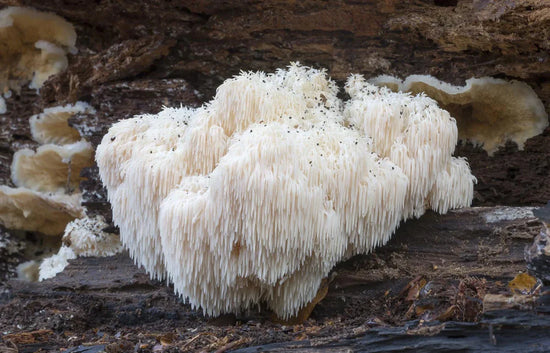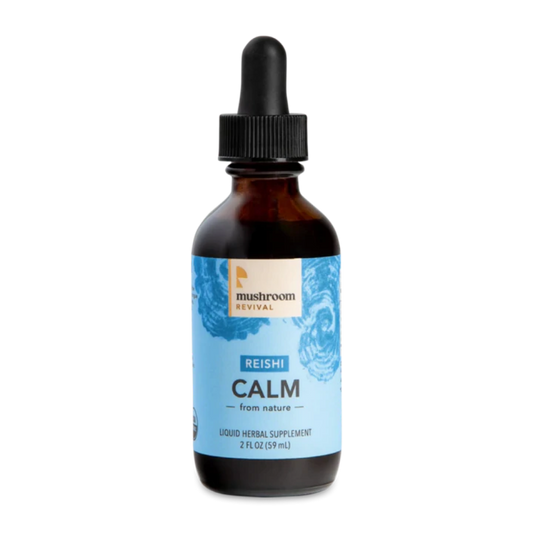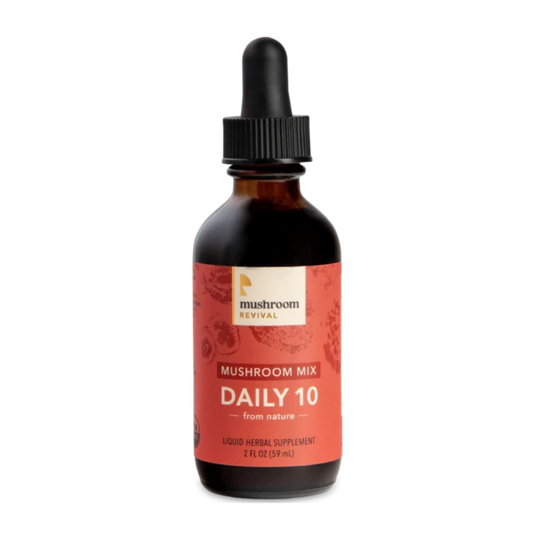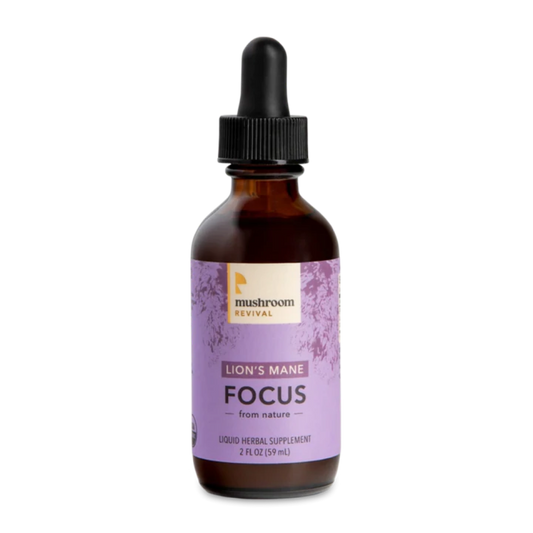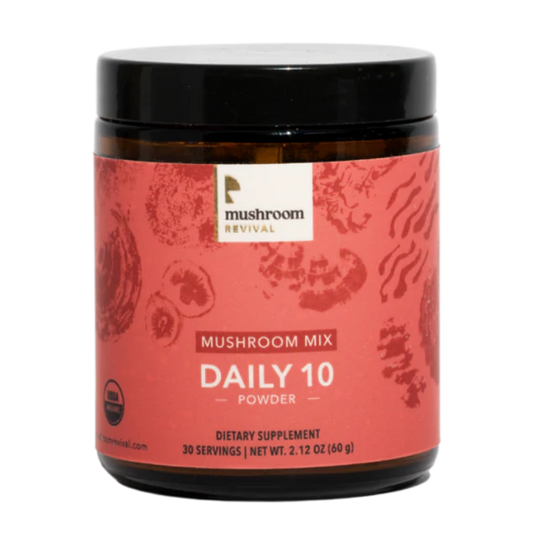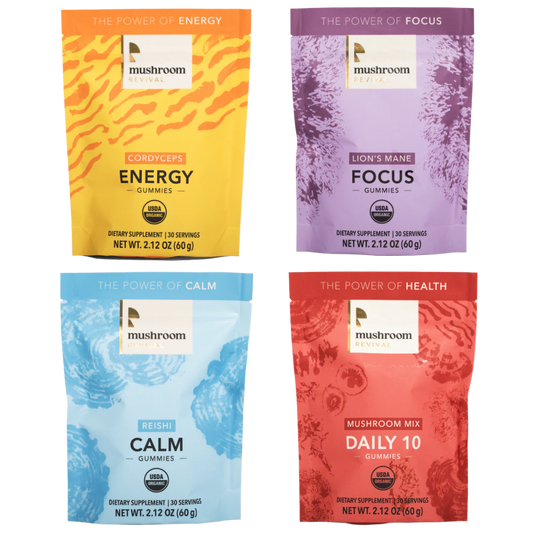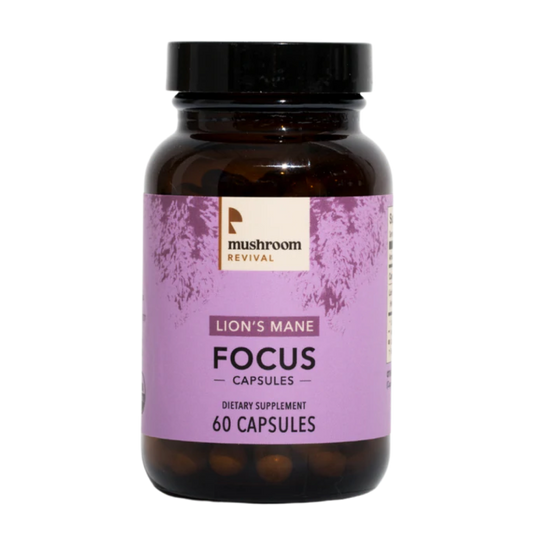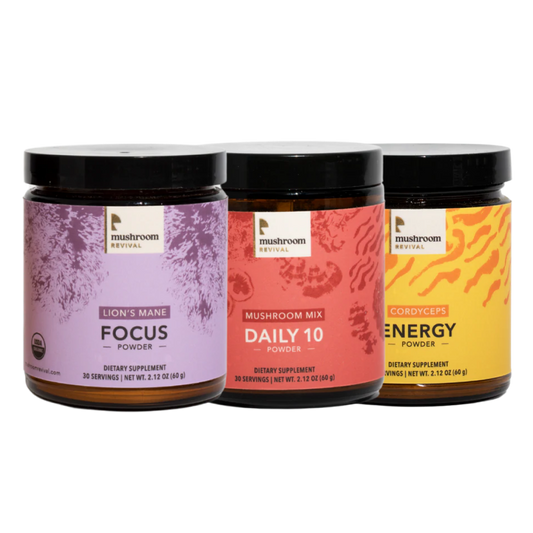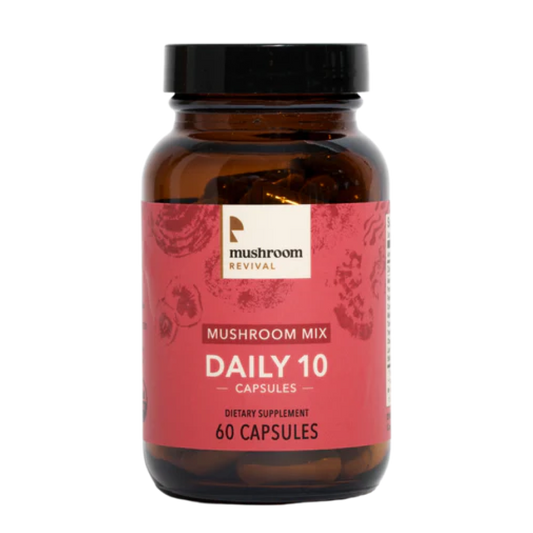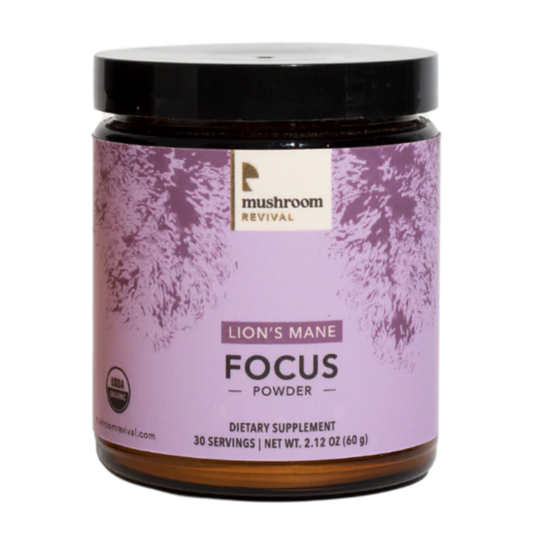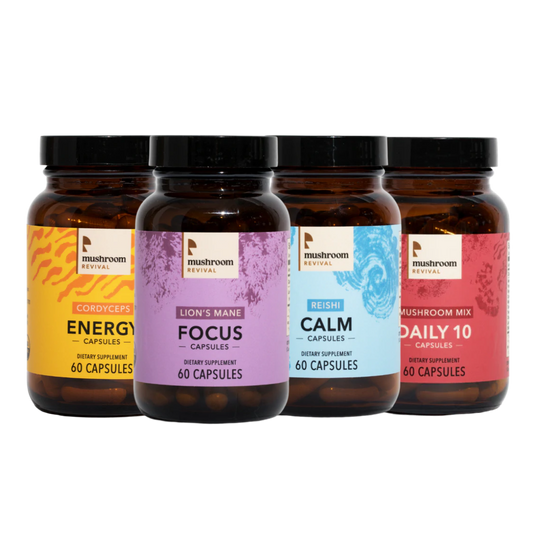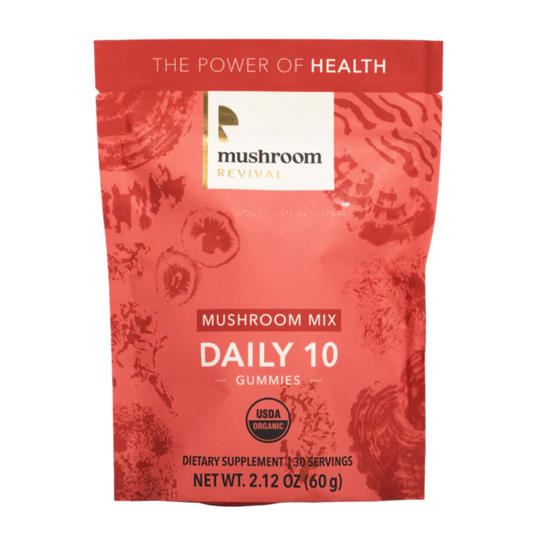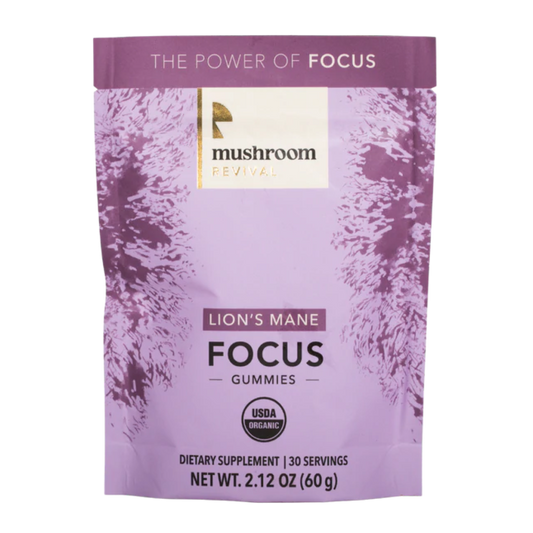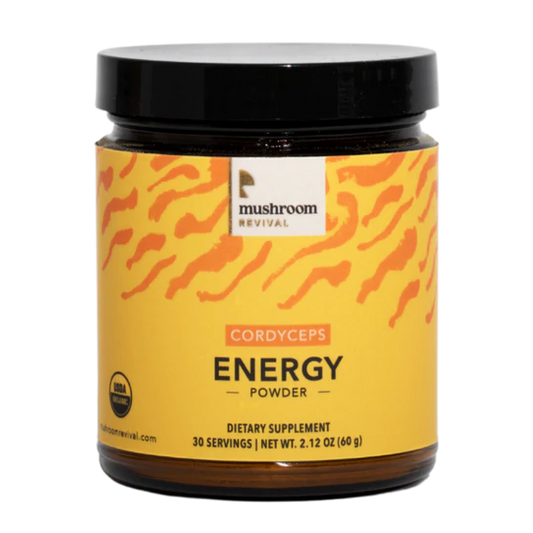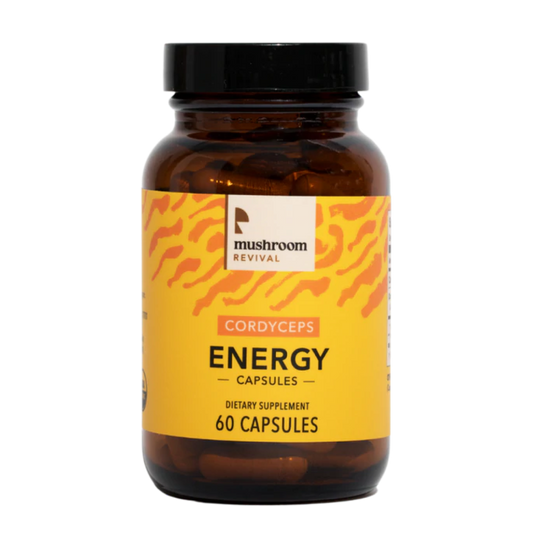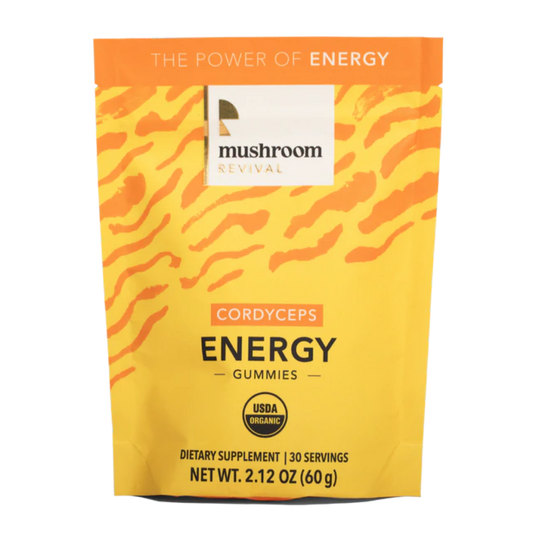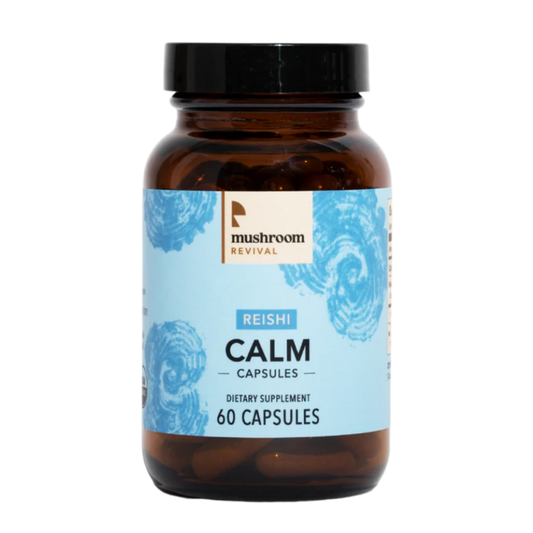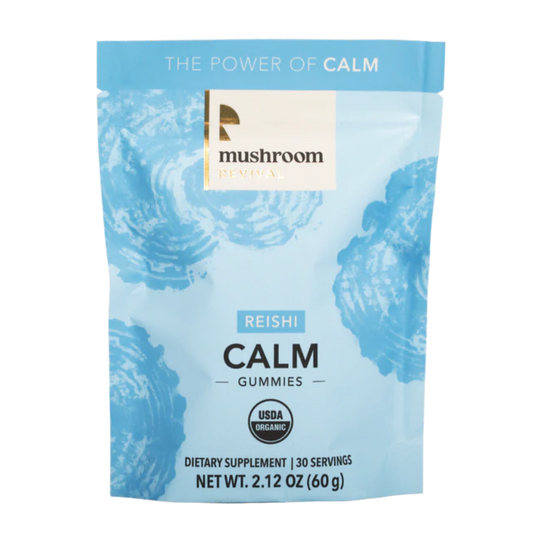Mushroom Chocolate
Love chocolate? You have fungi to thank for that, because technically all chocolate is mushroom chocolate. On today's show we are walking you through the complex journey between the cocoa bean and a chocolate bar. The unmatchable decadence is achieved by unique fermentation methods and microbes. Yeast, filamentous fungi, and bacteria are all at play and today we have a chocolate scientist and PhD candidate, Caitlin Clark, who has dedicated her research to chocolate fermentation.

Topics Covered
- Lactic acid fermentation versus chocolates specialty microbes
- The complex and ethical journey of chocolate making
- Alkalizing chocolate
- Polyphenol content in a variety of chocolate products
- Psychoactive properties in chocolate’s constituents such methylxanthine and theobromine
- How fermentation alters potency of these constituents
- Mycorrhizal, endophytic, and pathogenic fungi involved in the cacao trees
- Other fungal relationships such as endophytes and mycorrhizal species
- Microbiome of fermentation in cocoa including yeasts, filamentous geotrichum, bacillus bacteria and more
- Wild ferments, aseptic ferments and experiments with starter cultures
- Chemical and mechanical ways that fungi transform the stock
- What determines a ‘good’ microbial presence versus a ‘bad’ one in the chocolate making process
- How cocoa byproducts are made
- Bloom in chocolate
- How to shop for the best quality chocolate
Show Notes
- Caitlin’s website: https://www.trimethylpyrazine.com/
- Caitlin’s Instagram: @chocolate.graduate
- Chocolate Vendor’s
- Bar & Cocoa: https://barandcocoa.com/
- SOMA: https://www.somachocolate.com/
- Quntu: https://en.qantuchocolate.com/
- Nuance Chocolate: http://www.nuancechocolate.com/
- White Label: https://www.whitelabelchocolate.com/
- Ethical aspects of the cocoa and chocolate value chain
- Natto: https://en.wikipedia.org/wiki/Natt%C5%8D
- Mycotoxins in chocolate making and cocoa products
- Further reading: https://drive.google.com/drive/folders/1-DNBQ5kJRWPWm1nZXzjGH-VMgLJBtjsC?usp=sharing
TRANSCRIPT
You're listening to the mushroom revival podcast.
Lera 0:06
Chocolate is one of the most widely consumed and loved foods. And while it's a globally familiar commodity, most of us consumers are oblivious to the complex journey of a chocolate bar. We are covering this on our mycology podcasts because it turns out that fungi plays a vital role in creating the chocolate we all know and love.
Alex 0:25
When we think of fermented food, we typically think of sour foods like kimchi or kombucha, but chocolate actually has a lot in common with these historical staples. It too is fermented and not only by the ever present yeast, saccharomyces service CA, but also with lesser known filamentous. fungi, the flavor we define as chocolate. That's partially thanks to some metabolic products from the mycelium.
Lera 0:53
So today on the show, how do fungi transform, bitter cocoapods to the decadent matchless treat, we know to be chocolate.
Caitlin 1:10
My name is Caitlin Clark, and I study the fermentation step of chocolate making at Colorado State University that's under the heading of food science. So a lot of my peers work in nutrition or food safety. But I've chosen to focus on fermentation.
Lera 1:26
I'm so excited to get into the science of this. But before I'm interested in your personal story, did you start off in microbiology and then end up in fermentation? And then you're like, you know what chocolate than that, like how what was your trajectory?
Caitlin 1:40
So I started out in linguistics, actually, my undergrad was in linguistics and classical languages, Latin and Greek. And then, because of that, I got a really nice job in Madrid, Spain. And I worked in Madrid for a while doing different things, but using using my linguistics degree, and I thought I would stay there permanently. But because I spoke Spanish and understood, some of the other Mediterranean languages could interact in Portuguese and French. And so I really got invited into some of the local food cultures in a way that a tourist doesn't. So I got to participate in sausage making and cheese making and, and I lived on some farms and really learned some aspects of food culture that I would never have learned otherwise. And after doing that for a few years, I realized that that was what I was more interested in. And specifically fermented foods, cheese and sausage is what I thought I wanted to study. So I came back to the United States specifically to go to Colorado State University because they have a food science program that focuses on fermentation. And at the time, there were only a few of those now there are more, I started chatting with. A guy here had just opened a local like chocolate shop, right in Fort Collins, which is where the university is located. And he happened to mention as we were chatting, I mean, it had just opened like a week before I got here. And he mentioned it was fermented. And I was like, oh, cool fermentation. That's kind of my thing. And we got to chatting about it. And he kept I would ask him questions. And he would say, I don't know. I don't know, nobody knows. And I realized this is really an understudied area. This is this is a fermented food. Nobody knows anything about as opposed to cheese and beer, which people are really familiar with already. There's a lot already known about that. So chocolate is an area I can really add something to the field. And yeah, and that was kind of what got me into it. And then I the obsession really took over. And then then that guy hired me and I worked at his chocolate shop for years and he was wonderful and supportive and, and his chocolates wonderful. He and his wife make the chocolate. Yeah, and then now that's what I do.
Alex 4:04
When I think of fermented foods, kombucha, sauerkraut, beer, wine, yogurt, cheese, etc, immediately comes to mind. But honestly, I've been studying fungi for many years. And it wasn't until recently. I figured out chocolate is also a fermented food. Why do you think this isn't common knowledge?
Caitlin 4:23
No one ever thinks of chocolate because the fermentation step is completely separate from the processing that happens kind of closer to the people that consume it. And that's one thing that makes it such an interesting food, ethically and economically, is because the fermentation stuff happens on the farm, which is in Latin America, Africa, these days, parts of Asia Pacific, then later it comes closer to the people who are going to consume the chocolate. So it comes to Europe and the United States, kind of the typical consumers, and it's for the process there. So it's really very distant from the fermentation stuff. Yeah, well like beer, we have breweries here, people can go and see a fermentation tank where their beers being made.
Lera 5:06
Many fermented foods all have an essence that is indicative of fermentation. Notably that sour, almost sparkly or effervescent element. But the flavor byproduct of chocolate is so unique that most of us wouldn't think to group it into a fermented food. But without this fermentation, the raw material would be nearly unrecognizable. To many of us
Caitlin 5:27
view tasted raw chocolate, you'd be amazed how different it is then fermented chocolate, it's recognizable as chocolate. But I mean, it's not the same food at all. It's super bitter. It's highly astringent, it almost tastes like artificial chocolate, like somebody did a bad job making artificial chocolate like it's not the same food because fermentation is really what develops the compounds that will later make it tastes like chocolate, a lot of those, my art reactions that happened during roasting just hasn't become chocolate until you fermented. So you're right that it doesn't have that kind of sour thing that we associate with fermented vegetables. A lot of people when they think of fermentation, they think of pickles, sauerkraut, kimchi, yogurt, sour beer, those are all lactic acid, bacteria fermentations and lactic acid bacteria actually don't play much of a role in chocolate. And that's why you don't get that particular flavor that you're thinking of.
Alex 6:22
I was in Ecuador, and was blessed to to visit a chocolate farm and saw the whole process. And you're right that not a lot of people know, right, how cocoa is grown and how it's processed and how chocolate is made. Do you want to start by you know, from from the plant to the final, you know, on the shelves at Whole Foods or something like that, what is the typical journey of, say, a chocolate bar?
Caitlin 6:50
Sure. So, cow. So chocolate starts as the tree Theobroma cacao, and it grows these oddly shaped, colorful pods that are about the size and shape of a football. And inside of these pods, our seats, and the seeds are covered in this juicy pulp that kind of has the texture of snot, it's real mucilaginous. And these pods are cut off the tree. And then you have to crack them open and scoop out all of the seeds and the pulp. And the way this is done depends on where you are depends on how much quantity you're going to be fermenting, and what tools you have access to. But typically, like what you probably saw in Ecuador probably involves scooping those seeds and pulp into wooden boxes. And then you gather a large quantity like many, many kilograms, and then it will ferment. So you have the beans and the pulp going through a fermentation together. And that fermentation process will take anywhere from three to the, if you read about it or look it up, it'll say about a week. But I've seen fermentations as short as three days and I've seen them as long as 14 days. So really, it's all over the map depending on the conditions that they're fermenting under. But they go into this box and they have to be turned, it's really important to turn or stir the fermentation. So that will have to happen daily throughout the fermentation and gradually the pulp will drain away as it breaks down. And the beans will turn the seeds are now called beans, they'll turn brown and start to dry out. When the fermentation is done and the pulp has completely drained away and you're just left with these beans, you have to dry them out. Because they're still about 60% moisture, you have to get them down to about 7% moisture. So they're usually dried under the sun. Sometimes there's some kind of mechanized drying, then that takes a few days, then you have to often sort them somehow by quality or by size. Then you gather those sort of beans into these big burlap sacks and those sacks are what is then transported to wherever the chocolate is going to be finalized go through its final process. So often that'll be somewhere in Europe or the United States. Then it goes through a whole series of other processes. So it'll be once it gets to that destination. It'll be roasted first. And once it's roasted, then it will go through a process called cracking and winnowing which is where you have to remove this kind of papery outer husk from the interior which is called the nibs. The nibs is like the meaty part. The husk is a waste product. We don't use it in chocolate making but it can be used for lots of other industries. The nibs then, depending on whether you're doing a small scale or large scale process, the next few steps are kind of different, but essentially The nibs are crushed with sugar. And sometimes milk if you're making milk chocolate, and you have to crush it until it's so smooth that your tongue can't distinguish any difference in particles. And then the final step is that you have to temper the chocolate and tempering is a process of controlling the crystallization of the fats. There are different ways the fats can crystallize. And if it's not controlled properly, they can get kind of crumbly, or they won't reflect the light properly, or they won't melt at the right temperature. So you have to do it in a way where it comes out all shiny, and it snaps when you break it. And once you've done that, then you can pour it into the shape of a chocolate bar, or you can use it to make truffles or whatever else you're going to do with it. So it's quite involved.
Alex 10:49
This is truly a sacred commodity. And to help us understand, as we dive even deeper into this process, we asked what would chocolate be without fermentation? Would it be edible? What color would it be? How would you even consume it,
Caitlin 11:03
it would be edible, it would be very different. There are actually a few cuisines that use unfermented chocolate, a few Latin American dishes, and a couple foods in the Philippines that use unfermented cocoa beans, I shouldn't say chocolate unfermented cocoa beans to make certain things. But the the they're not really chocolate beverages, there's something quite different. So yeah, it is perfectly edible. But it tastes really, really bitter, which is really why it's used. Sometimes you desire bitterness in certain applications. And so you might use it for that. And it's a very different color. So cacao beans, when they're not fermented, are usually really purple. Now, there are some varieties that are white, they're they're pale purple, or even white. And these varieties are really desirable, because they're usually associated with really wonderful flavors, they tend to be quite floral, or kind of have these honey like flavor attributes that's associated with these albino or white beans. But they're quite rare, most of the cocoa in the world is very dark purple. And that's last defragmentation because those are polyphenols that are purple, and they're broken down gradually through fermentations and converted to compounds that are brown colored. Instead,
Lera 12:20
I've heard people reaching for cocoa powder and dark chocolate for the poly phenol content. But in your article you alluded to how that's kind of a misconception is that I mean, if you go to health store and you buy a thing of raw cacao powder, if it's not purple, is there no like real source of poly phenol? How should people be looking for cacau? If they're going for the poly finos?
Caitlin 12:46
Well, if you want polyphenols in your diet, you should be going for vegetables and not dark chocolate. So dark chocolate probably does contain some polyphenols, it's really hard to know how many because processing differs so much. I mean, I gave you a brief overview of how chocolate is made. But really there's a lot of variability in the process. For example, some chocolate is what's called Have you ever heard the word dutched? Yes, but I don't know chocolate. It's a process of alkalizing chocolate, it means that you soak it in an alkaline solution and it removes a lot of the acids. And there are a lot of reasons for doing that. It's often done to cocoa powder, because it makes it more dispersible in water or milk. It also gives it a really nice dark color and kind of like a chocolate or flavor. And also doesn't react as much with baking soda. So it can be good for some, but that takes away like if there are any remaining polyphenols that takes them away. So if you buy non dutched, or it's called natural cocoa powder, there are probably some remaining and often it has like a reddish color. So you can even kind of see them in that reddish color. So an average like people have tried to study this. And studies show that a dark chocolate bar just like a really good quality dark chocolate bar has not been touched, processed. probably has something like point five grams of polyphenols per like a 50 gram chocolate bar. So that's not very much you're just going to get more polyphenols if you eat colorful vegetables.
Lera 14:25
Thank you for debunking that myth. I found so many articles. There might be dark chocolate for this and perhaps that's true, but before you ferment it right before you process it.
Caitlin 14:35
Sure if you were to eat on fermented cacao, you'd get a ton of polyphenols.
Alex 14:39
I'm guessing you have but have you had chocolate liqueur.
Caitlin 14:42
Um, so yes, but let me clarify what you're asking. Are you talking about chocolate liquor or chocolate liqueur?
Alex 14:49
I don't know. I was actually trying to Google this because at that, that cacau farm, they had a couple different concoctions And it was so many years ago that I can't remember exactly what it was. But I remember it being the most delicious thing on the planet. And it wasn't only delicious, but the effects of the alcohol. Like I got drunk off of it. And it was a it was similar to wine drunk that you're just happy and full heart, you know, but it was, it was a cow. And like, it was such a heart warming. You know, it was almost like an entheogen. It was almost psychoactive, everybody was Yeah, you see the effects of it.
Caitlin 15:31
So yeah, you're you're talking about liquor, chocolate liquor and, but really what you're describing that psychoactive effect, you could get from anything that is high, high enough in chocolate, you'd get it even more from just eating a high enough quantity of a really good chocolate bar. Chocolate is psychoactive because of the theobromine. So it has methylxanthines in it, it has principally caffeine and theobromine. And there's one other one, which is a really low concentration. But I mean, everyone's familiar with caffeine from coffee, and everyone knows what it does to you. So theobromine is a related molecule. And it gives you a similar high, but it doesn't, it doesn't come with that heart racing kind of. It's not panic inducing. Um, it gives you more of a mental lift, and it also lasts longer. And it has a not as much of a steep lift and drop. So it's kind of a gentler lift, and it drops off more slowly. So you don't notice like this kind of intense like, punch me in the face, I'm going to panic that the caffeine gives some people. So a high concentration of that kind of methyl xanthine can definitely be psychoactive. That's probably what happened to you probably, yeah, well, the
Lera 16:46
methyl xanthine content change with these fermentation approaches?
Caitlin 16:50
Yeah, fermentation does reduce methylxanthines. But they're still quite at significant levels post fermentation. What do you know about the endophytic, or mycorrhizal relationships of deca cow tree? And
Lera 17:04
how much of its properties are due to these relationships with fungi?
Caitlin 17:09
Yeah, so after I gave you that note, I thought I should clarify, this is definitely not my area. I don't know a lot about the horticulture. But I do know that these are the cacao tree does have both like fullier endophytes. So it has on its leaves, it has endophytes. And they tend to be I don't know a ton about them. I do know that they're different than like endophytes are usually studied in grasses. And I know that the ones in cacau, I think like any tree, they tend to be horizontally transmitted. So like they they pass them to each other, whereas in grasses, they're vertically transmitted. And the other thing that's interesting about the folio, endophytes, and cacau, is that they're pretty closely related to the pathogenic fungi of cacau. So there have been some studies on the interaction between those two groups of organisms.
Lera 18:03
Pick out trees also have important micro raizel relationships. Specifically, these trees can't fix enough phosphorus on their own. So to obtain a healthy amount of minerals such as this, they rely on micro raizel relationships. For more on this, check the show notes, but this episode is highlighting the lesser known roles of fungi and transforming the actual cocoapods into the beloved chocolate.
Caitlin 18:25
So there are a lot of fungi involved in the fermentation process, both yeast and filamentous fungi, the microbiome is pretty complex and the fermentation process so it starts out with a yeast dominated kind of early stage in which there's not a lot of oxygen because the pulp is still present. So the cocoa beans covered in their pulp are packed into these boxes, or piles, or sometimes trays or whatever tool is being used. But we'll talk about boxes. And then they're covered usually with banana leaves. So this is a really low oxygen, almost anaerobic, or we could say micro era philic environment. And so in this stage, yeast will dominate but there definitely have been filamentous fungi found, and we'll probably come back and talk more about this later. And this is the stage where the yeast are converting the sugars of the pulp into alcohol. That's kind of the main reaction that's happening in the stage. And also the pulp is breaking down, and that's from pectin aces that are produced by the yeast. And there are also a lot of enzymes produced by filamentous. fungi that break down the pulp. Although yeast are dominant, you definitely have important action by filamentous fungi here. And because the pulp is breaking down, it'll start to drain away. So these boxes have some sort of drainage, and the pulp will because the pulp is like mostly water, right? So it'll kind of drain away as its pectin breaks down. And then as the pulp drains away, more oxygen can get in and so that's when acetic acid bacteria A takeover. And they'll convert the alcohol that they use produced into acetic acid. And that acetic acids soaks into the bean and it will kill the plant which has started to germinate. And it also causes a lot of interesting biochemical reactions inside the bean. It'll cause the sequestration of different compounds, it'll cause substrates to come into contact with their enzymes. And it also just creates a very different environment in terms of fungi, fungi that were more active in the earlier stage or less active in the stage, because there's more oxygen, very different Ph. And then the final stage of the fermentation is where the pulp has been kind of completely digested, you have the beans that are still quite wet, but are starting to brown. And there's still quite high moisture, so you have enough moisture where filamentous fungi can grow. So some of these species have been present the whole time. Like they're probably there's evidence that shows that chitrakutdham species are present early in the fermentation. So these will start to really take over at the end of the fermentation. So a lot of filamentous fungi at the very end. And then you also see some bacillus species bacillus is a bacterium, which is pretty active at the end of fermentation. So throughout that entire time, the fermentation heap or mass is being stirred or turned. And that's probably one of the things that keeps the filamentous fungi at bay until the very end, because it's my silly are being disrupted every time that it's turned. So that's just an overview of the fermentation.
Lera 21:46
This all seems to be native. Yes. Wow, wild culturing is that the case for all cow?
Alex 21:53
Like, great question farmers have, you know, I know a lot of bread makers, like have specific strain of yeast. And they've been using the same one forever to do any of these kick cow farms, like have a stream that they intentionally inoculate or they just leave it out. And wild, you know, fungi will come Yeah, to it or any any sterile lab processes that they they inoculate in kind of a sterile setting or something like that.
Caitlin 22:21
So this is a super interesting question. Basically, yes, or no to all of the above. So in general, all fermentations are wild, meaning that the both the yeast and the bat or the the fungi and the bacteria come from whatever is in the environment. So a lot of times this is going to be from the surface of the pod as the pod is broken open. But it could also be from the tools or the hands of the people who are working with the cow. But also it's from the fermentation vessels. So the boxes or the trays or the piles that have been used before. On one hand, that's not a ton of control. There's a lot of room for variability there. If you hire new workers, they have an entirely new microbiome on their hands, right. But on the other hand, if you're using the same fermentation vessels, that's a form of inoculation. If you're using the same boxes that you used before, you're going to be reintroducing the same microbiome. And in fact, I know a farmer who recently made new boxes because he started working with larger volumes, and he wanted to make larger boxes. And he took pieces of his old boxes, and stuffed them into the first fermentation that he did in his new boxes because he wanted to inoculate. He liked the quality of his fermentation so and he wanted to keep that same microbiome. So he inoculated his new boxes with pieces of his old boxes. I've also heard of people I only know anecdotally people have told me that they've tried using other foods as a form of inoculum. So I know a farmer in Hawaii, who inoculates us from mutations with puoi. So point is a fermented Hawaiian kind of putting like food, it's fermented with lactic acid bacteria. I didn't really mention lactic acid bacteria before, they are not super dominant and kickout fermentations but they're pretty important, but they tend to be in the background. But this farmer throws puoi into his fermentations. I've heard of people adding a kombucha scoby to their fermentations. Now, in the lab, there have been some really interesting experiments done, yes, with aseptic fermentations, but also with inoculating fermentations with a specific starter culture. There have been people who have done work with like different species of yeasts or with mixes of yeast. There was an interesting one where they used a strain of servi ca that produces higher esters, so esters that are not acetate esters, because our acetate esters tend to disappear really quickly. And the non acetate esters are retained, they're a little less volatile. So they inoculated it with the strain of servicii that produces these higher esters, and then found that in fact, the resulting chocolate was more flavorful and had more of these floral flavors that you get from these higher esters. There have been some other non surrogacy species tested, there have been some Candida species tested and some pizza, some hens, taneous worry, I've been tested, I think it started cultures.
Alex 25:31
How much do you think that affects the the taste and the texture of the overall, you know, final chocolate product,
Caitlin 25:40
the work shows that, at least in some of these studies, taste panels can distinguish between chocolate that has been inoculated with one startup culture versus chocolate that was started with a different starter culture, at a statistically significant level like that they there's a statistically significant difference in people's reactions to those chocolate. However, it doesn't tend to show up as much of a difference when you look at like the GCMS spectrum. Right? So how different is it? Really? I think probably there is a difference. Yes. I mean, chocolate is a succession, meaning that each species or group of species paves the way for the next one, right? So when you're inoculating a startup culture, you're changing the starting environment. And that means that every environment that comes next is going to be different. So I think you are going to create this domino effect for the whole fermentation that is going to have maybe only a subtle effect, but certainly a noticeable effect. So yeah, I think this is probably where the research is going in this industry. This is where they're really interesting work is probably going to be in the next few years, to effect flavor, at least. Yeah, it's
Lera 26:55
exciting what species of micro organisms are vital to make this transition. And when I was reading a paper that I saw, there were like, maybe 11, or 12, filamentous fungi present, but they're not necessary for the cookout to become chocolate. But what right organisms are
Caitlin 27:13
so definitely, in the yeast like the early stage? Well, I should start by saying that in each stage of the fermentation, the yeast stage, followed by the acetic acid stage, followed by the final stage, where you have the usually some facilities, and then behind all of that you have some lactic acid. I mean, there are probably dozens of organisms in each of those categories participating in it. cacau fermentation, it's really difficult to overstate how complex these permutations are, we're used to thinking of fermentations like beer, where you put in a single organism, and it does the job. And cacau is just not like that there are so many organisms participating. And when we study them, and we try to find who's participating in these micro biomes, in different fermentations around the world, we do find some overlap, but maybe not as much overlap, as you might expect, they really are quite different. And yet, they're getting a pretty similar job done. So that tells us that it's really more about the environment, like maybe it's not this specific yeast that needs to be there. But we just we need some yeast with pectin, oolitic activity, we need some species that can break down the pulp. And it doesn't make a huge difference which species that is in order to give that result. Does that make sense?
Lera 28:33
Yeah, that makes perfect sense. Is there any like an enzymatic activity that yeast or filamentous fungi can offer that bacteria cannot? And vice versa?
Caitlin 28:43
Yeah, so definitely the the breakdown of the pulp comes principally from yeast and filamentous. fungi, partially because of the breakdown in the pectin. And also partially because and that mostly comes from from yeast, especially sacrifice, the service, the sacrifice, the service is pretty much founded every fermentation that's been studied. In fact, I think it would be safe to say every now isn't probably the same strain that we find in our bread and our beer, but it's the same species. But we also find like, early in that early stage, gh akiem is often involved, or some other filamentous fungi, that is that's microaerophilic and tolerant of a high water activity. And it's super useful in that stage not only because of the enzymes it releases, which do break down that pulp, but also because the mycelia actually helped pull apart the the cells. So it's actually mechanically helping to separate some of the components. So it's, it's mechanically breaking down that fermentation, as well as enzymatically breaking it down. So that's an in fact some producers choose to not stir for the first two days, whereas normally I mentioned that you, you want to turn or stir your fermentation, usually every day. Some people give that early stage two days without stirring. And one of the reasons is to give just a little bit extra time for that breakdown. Because those filamentous fungi are active. It's it's really it's unknown, in terms of science hasn't studied, well hasn't been able to study well, exactly what they're doing. But anecdotally, people who practice fermentations kind of know what works and what doesn't and know the role of them. And then there are definitely like later in the fermentation, there are filamentous fungi that play a big role. So towards the end of fermentation, when things are starting to dry out, and there's more oxygen available, then, often you see filamentous fungi, and they can be good, but they can also be really bad. It depends a lot. So they're the thing about these filamentous fungi is that they have proteolytic and lipolytic activity, so they're going to break down proteins, and they're going to break down fats. So this can be good. When you break down proteins, you can get this interesting umami flavor. And I've had chocolate that has this super interesting flavor, it can get kind of earthy, but if it goes too far, it gets a flavor that my old boss used to describe as dog food. And yeah, so it does, that is what it tastes like if it goes too far. And then the other thing that can happen because of the lipid breakdown is that because cacau fats, which we call cocoa butter is a super, super stable fat, it doesn't really have short chain fatty acids. But if you break it down, then you release some of these short chain or free fatty acids, which are not resistant fats. So they're very prone to rancidity, they get this hydrolytic density and they can taste like cheesy and like fully like feet. So the main role of these filamentous fungi later in a fermentation, if they just participate a tiny bit can be quite beneficial, but if they're allowed to go too far can ruin a good fermentation.
Lera 32:19
Wow. Quick question is that how do you get cocoa butter out of that process.
Caitlin 32:26
So you have to press the beans under like, it's this huge machine that just puts an incredible amount of pressure, I don't even know what it is. Then, once that happens, you basically put a bunch of fermented and dried and roasted cocoa beans in this press, and it'll squeeze out the fat, not all of it, but most of it. And then what's left behind is cocoa powder. So you've had cocoa powder that you buy for brownies or whatever. That's what's left behind after you squeeze out all the cocoa butter, but it still has cocoa powder still has somewhere between like 10 and 25% fat in it. So you really can't get it all out.
Lera 33:03
So there's some foods out there from fungi that the organism itself is the foods or nutritional yeast, for example. And I'm wondering how much of the end product of your chocolate like how much of that biomass is dead microbial Carnage that may or may not contributing to the flavor profiles? Do you know if like the presence of its weight has anything to do with the final flavor profile?
Caitlin 33:30
That's a really interesting question i i would guess, not very much. Because most of the visible what I really liked your description, the hyphal network, it is often visible on cacau that you dried finished cacao beans, when a chocolate maker purchases beans, and imports them from Ecuador or Vietnam or Cameroon. They come in this big bag and then you're gonna scoop them out and then finish your process. And when you scoop them out, they all look like cow beans, but they all look really different and many of them are covered in filamentous fungi. I've worked with a bunch when I worked at this chocolate shop here and a few specifically like would be white like the beans would be white. But the thing is, that's the husk that is being covered and that husk is going to be removed when you go through that cracking and winnowing step that I talked about earlier. So that really won't be used at all for chocolate making that might be used for composting or sometimes it's used for like vermiculture or brewers use it for brewing, but it won't be used in chocolate making. So it might end up somewhere but it won't really end up in the chocolate.
Lera 34:47
So I have seen chocolate bars that have kind of this like dusty almost like razor burn looking. Yeah, stuff on it. What What is that?
Caitlin 34:56
That's called bloom and it's actually a result of The fats coming out of temper. So earlier I discussed that the last step in chocolate making is called tempering. And that's where you control the crystallization of the fats. The fats can crystallize in all different ways and some of the ways that they crystallize refract light differently than in the desirable shiny way. And if they're subjected to temperature changes, or even moisture changes, or sometimes just age, they will recrystallize in one of those undesirable ways, which doesn't refract light adequately, so they appear less shiny, or sometimes even white or creamy. And they also usually, if you were to put that in your mouth, it would taste a little waxy, it may not melt at the right temperature, and it can be a little crumbly in texture.
Alex 35:45
Do you or your lab have a favorite fermentation of all time?
Caitlin 35:51
Um, I have a favorite fermentation, but it's not fungal. What is it? It's called Nacho. Have you heard of Oh, hell yeah. Do It's so weird. It's weird. Yeah. So my God, it's so weird. I'm so glad you like it.
Alex 36:12
It's stringy forever. Like, it's so good.
Caitlin 36:15
Every year I try to get my students to eat it and like get in every year I fail. They don't like it.
Alex 36:20
It's definitely an acquired taste.
Caitlin 36:21
Yeah, it is. Yeah,
Alex 36:23
I can't remember it. Was it like a mix of mustard, soy sauce, and maybe one other ingredient. And then
Lera 36:29
the directions were so funny. At least the place that we purchased it was like Star 60 times and unlike the soy sauce, and it sounds like really gross. But I my gut was singing.
Alex 36:42
Yeah, after that. Yeah.
Caitlin 36:43
It's so glad you once you get used to it. It's delicious. Yeah, I'm
Lera 36:48
a big fan of nado. Good for you, guys.
Thank you.
Alex 36:53
So what about chocolate? Do you have a favorite type of chocolate? Do you recommend just you know, understanding the science of you know, chocolate tearing? And, you know, cacau? What would you recommend for hungry consumers that love chocolate themselves? What would you recommend that they look out for, you know, on the shelves? And, you know, do you have any favorites yourself?
Caitlin 37:19
Well, okay, I'm going to jump on my soapbox here for just a moment and say that, if you really love chocolate, you probably can't find the type of chocolate that's going to stoke your passions at the grocery store. There is some really wonderful chocolate being made out there. But you just cannot sell chocolate like that for $1 or $2 or even $5 a bar, the chocolate that really is going to knock your socks off, you have to put a little bit more of you know a higher price tag on that because because the chocolate makers that are making that are actually paying the farmers quite a bit more for their beans, because the beans cost the farmers more to produce. High quality cow beans come from different varieties of cacao trees that are not as high producing that are not as pest resistant. So it actually the farmers have to be compensated for working with those varieties and accepting a lower yield. And so those beans cost quite a bit more. And then the process of making those cow beings into artisanal chocolate is a little bit more involved. It's uses different equipment than industrial chocolate, and takes quite a bit longer than making industrial chocolate. So you just can't, you can't put that at grocery store prices. So there are places where you can get it. I am going to mention a few brands or a few chocolate makers in particular that I think really knock it out of the park. But there's a website it's called bar and coco.com. So it's literally those words, it's b a r a n d COCOA a.com. And they are kind of a distributor of a lot of these artesanal chocolate makers. And their website is really great because you can search by, you can search for like just dark chocolate or milk chocolate or you can search for a particular flavor inclusion if you'd like raspberries in your chocolate, but you can also search by origin. Like if you're particularly interested in chocolate, that where the beans originated in Peru, you can search for that. Or you can search for chocolate makers from a certain place if you want chocolate made in Austin or in London, you can search for that. So it's a really great resource. And they sell bars from a couple of my very favorite chocolate makers. One of those is Soma s Oh Ma, I think they're just wonderful, just really wonderful. And then another one is called cuanto. And they spell it funny, it's QAN t au. They're in Quebec. And their bars are just so unusual. I think they, they have an interesting they, they they ferment their beans differently than other people, they ferment them a little less. And I think they come out tasting like wine. Oh, interesting. I just, I love their bars so much. They're my very favorite. There's also that there are a few that you can't get on bar and cocoa that are worth mentioning. So the chocolate maker that I used to work for, I think really makes dynamite chocolate. And they're here in Colorado, their name is nuance. And their website is just nuance chocolate calm. And Toby and Alex make really wonderful chocolate. And they also have a huge variety of origins. I think, as far as we know, they have the widest variety of single origin chocolate that anyone's making right now. And then there's a maker out in California called white label, which is a white label, chocolate calm, that just think makes the nicest, like, if you wanted to give a luxury gift to someone that that's where I would go, they just make this incredible. Their bars are around like $18, but boy, they're worth every penny.
Lera 41:39
So amazing. I just wrote down all of those things. And for everyone listening, it'll definitely be in the show notes. So is there any last things that you want to say about chocolate fermentation I know that we touched on are in the in our notes, mycotoxins and how you know, that's probably just goes back to how filamentous fungi can be bad. And that's an example.
Caitlin 42:03
Sure, yeah, um, mycotoxins have definitely been found in cacau. And even in cocoa products, they're probably not a huge, not a huge risk. They're not something I wouldn't worry about recommending chocolate, certainly to people because of a risk of mycotoxins. But it is a growing area of concern, thinking about 20% of the cases where they've been looked for they've been found in like in significant quantities. And then they're often found in insignificant quantities like in like, where their presence is detectable, but not really of interest. So yeah, that's just I mentioned that is just kind of a role that filamentous fungi can play in chocolate making. I mean, there are some pretty serious mycotoxins that the filamentous fungi that participate in chocolate fermentation can produce. But again, that comes back to rotting versus fermentation, right, we, we control a fermentation process, we dry it out part of fermentation is drying the beans, right. And so we drop the water activity to a level that these filamentous fungi can no longer survive. And in so doing, if we do it, right, we control the production of these mycotoxins. So I guess, part of that is just to recognize the the farmers who perform this fermentation process, it's usually performed either on a farm, or sometimes at a co op. Or farmers will take, like all the farmers from an area might take their beans to a co op, and then the fermentation will be performed at that Co Op by kind of people who are particularly skilled in the fermentation it depends a little bit regionally. But I just wanted to make that point that this is a very labor intensive process. And it's a process that requires a lot of knowledge and skill. And sometimes these farmers, they may not always know what they don't always know the science behind what they're doing. But they know what to do. And they know what works well and what doesn't work well. And if we have good chocolate, we can't have good chocolate without those people doing their job as well. Because what comes to a chocolate maker in the United States or in Belgium or whatever, is essentially already a product. It's not a raw material, it's already gone through a whole process. Because if you go through a bad fermentation process, you can't make good chocolate. You can you can ruin you can ruin it later in the process, but you can't save it. It's been badly fermented. So I think we tend to give a lot of attention to the chocolate maker like when you when you go on that website, bar and cocoa. It's going to be the name of the chocolate maker on the front of the bar and we don't give a lot attention to the farmers or the producers who did that fermentation process, but really, fermentation is what governs flavor. Yeah. And those are the people really who ought to be getting a little bit more attention, I think, and more sure of the profits, I think personally, but that's just a personal opinion.
Lera 45:18
Yeah, I agree. And I'm, you know, thank you for saying that because I have heard I think planet money, which is another podcast, they had a whole episode on Fairtrade chocolate and like, why, why that stamp is so prevalent on these products. And you know, most people who say they're Fairtrade, when you really look into it, it's not that great.
Caitlin 45:36
Yeah. No, really, there's some serious ethical concerns in the chocolate industry, like it's bad, but people are trying to make it better, and also younger consumers. This is research by my friend, Gina cabaye. She did some research that showed that younger people are starting to care more like they look at a package and they look to see like, does it have a picture of the farm on it? Or does it have some sort of certification, like just something that inspires a little bit of trust, that shows that this company cares about their sourcing and cares about where it came from, and it's definitely not perfect, it has a long way to go. But people are starting to gain gain a little bit of interest in the disparity that is still so problematic in the chocolate industry.
Lera 46:23
Encouraging data, though, from your friend. Yes, well, wonderful. This has been super illuminating. I for one, as a chocolate lover, and fungi lover will be the first to admit that I didn't know how intimately these things intertwined before I read your article, so yet another niche where fungi are showing up and making all of our lives a little bit better. They're everywhere. Yeah, definitely. Yeah. If there's any last comments that you want to make, we'd love to hear it. Great. I
Caitlin 46:54
so I do have a website. It's trimethyl piperazine. Calm, which is super nerdy. Yeah, I get it. when when when I made that website, I never imagined that I would be saying it out loud. To anyone else, let alone some sort of audience. It was it's just, it's just sort of where I keep track of my own work and my writing portfolio. And but but I do put my thoughts there sometimes about you know, I put things like what's the difference between conching and tempering? And you know, what is Bloom? And so if, and sometimes people ask me questions, and I answer them, so if you have any questions you want to ask me personally, definitely, you can go there and I'm on Instagram as chocolate graduate.
Lera 47:37
Amazing. I'm like, so happy I found you. I love that there's a researcher out there doing what you're doing. I can't
Alex 47:43
wait to order all these chocolate bars.
Caitlin 47:47
Thank you guys. I'm so excited. I can't wait for you to try some chocolate. There's a really good chocolate out there. It's gonna it's gonna blow your mind.
Alex 47:57
To the over 1 billion people around the world who eat chocolate every single day. And to the 268 million Americans who eat an average of 12 pounds of chocolate every single year. We can all thank fungi for making our lives just a tad bit sweeter. You can support the show and keep content like this coming by visiting our website mushroom revival, calm and purchasing any of our mushroom revival products to support your energy your focus sense of calm your immune system and defense against occasional stress all with the power of mushrooms. We are completely obsessed with mushrooms and want to spread it far and wide. podcast listeners get a special discount for 10% off. Just enter m our podcast at checkout. That's m our podcast all capital letters at checkout.
Lera 48:55
You can also support us by reading and reviewing. We would love to hear from you.
Alex 48:59
As always much love and made the spores be with you.








